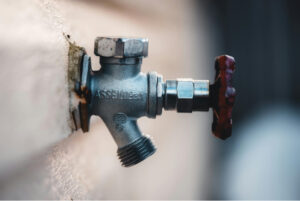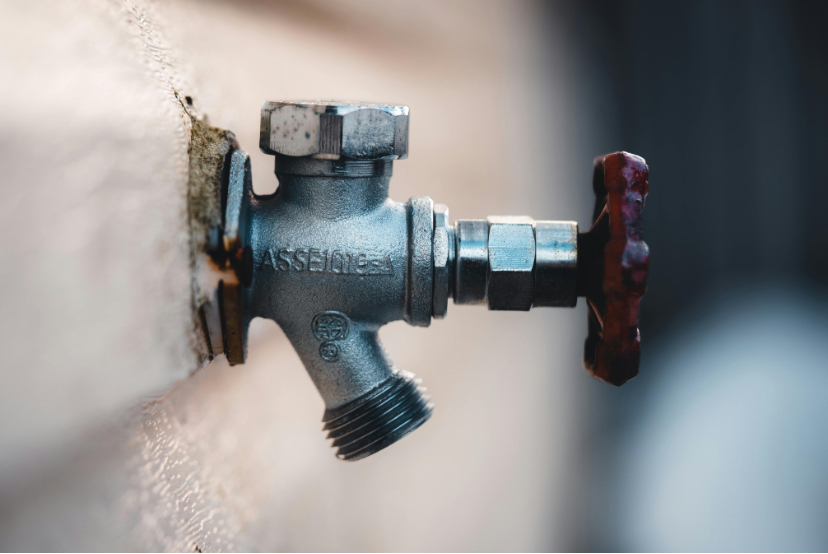What’s a Hose Bib and Why Should You Care?
If you’ve ever dragged a garden hose around your yard, chances are you’ve used a hose bib—even if you didn’t know that’s what it’s called! A hose bib (also known as an outdoor faucet, spigot, or sillcock) is the small tap on the outside of your home where you hook up your hose. It may seem like a simple little piece of plumbing, but it plays a big role in your home’s water system, especially when temperatures dip below freezing.
So let’s break it down.
What Is a Hose Bib?
A hose bib is the outdoor faucet typically found on the side of your house. It’s where you attach your garden hose for watering plants, washing your car, filling kiddie pools—you name it. But unlike indoor plumbing, hose bibs are exposed to the elements year-round, and that exposure can lead to problems if they’re not properly maintained.

Why You Should Check Your Hose Bibs Every Spring
After a long winter, your hose bib might be hiding a problem you can’t see: a crack in the pipe caused by freezing water. If you didn’t drain your hose and shut off the water before the first frost, there’s a chance water froze in the line, expanded, and cracked the pipe inside your wall. The scary part? You might not notice until you turn it on in spring—when water starts leaking inside your wall instead of out the faucet.
Here’s what to do:
1. Turn it on and watch. If water flows normally and you don’t see anything strange, you’re probably in the clear.
2. Check inside. Go into the basement or crawl space and look at the wall behind the hose bib. Any signs of moisture or dripping? Give us a call.
3. Listen for dripping. If you hear water running or dripping behind the wall, that’s a red flag.
What Happens If a Hose Bib Leaks?
A leaky hose bib can:
• Waste hundreds of litres of water over the season.
• Cause water damage inside your walls if the pipe behind the faucet is cracked.
• Lead to mould or mildew issues.
Even a slow drip is worth checking out—it could mean the washer inside is worn out, or possibly, that the whole unit needs replacing.
When Should You Upgrade Your Hose Bib?
Not all hose bibs are created equal. If your home has an older outdoor faucet, especially one without frost-free technology, it might be time for an upgrade.
Frost-free hose bibs are designed with a long stem that extends into the warmer interior of your home, keeping the valve seat protected from freezing. When installed properly, they can prevent the cracked pipe problem mentioned earlier.
Modern hose bibs come with built-in backflow prevention—it’s part of plumbing code now. But if you have an older faucet, it might be missing this feature. Backflow preventers stop potentially contaminated water (like from a garden hose sitting in a bucket of fertilizer or pesticides) from flowing back into your home’s plumbing.
Signs it’s time for an upgrade:
• Your hose bib drips even when it’s turned off.
• It feels loose or rusted.
• It freezes every winter.
• It’s not frost-free and you live in a cold climate like Prince George or Quesnel.
Tips for Hose Bib Maintenance
• Remove hoses before winter. Always disconnect garden hoses before the first frost to prevent water from getting trapped in the pipe.
• Drain the line. If you have a shut-off valve inside, close it in the fall and drain the exterior line.
• Check washers and seals. A worn washer can cause leaks even if the pipe is fine.
• Schedule seasonal plumbing checks. Especially helpful if you’re unsure about what kind of hose bib you have or how to winterize it.
Need Help with a Leaky Hose Bib?
If you’ve got a dripping outdoor faucet or suspect a freeze-up caused damage, The Family Plumbing and Heating has your back. Whether you’re in Prince George or Quesnel, our team is happy to check your system and make sure you’re good to go for the season ahead. Give us a call at (778)764-1149
— The Family Plumbing and Heating Team

